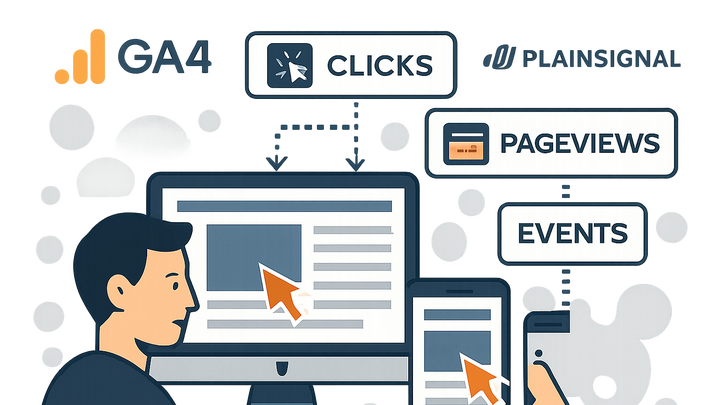Published on 2025-06-26T05:10:02Z
What is User Tracking? Examples and Applications in Analytics
User Tracking in analytics is the process of collecting and analyzing data about how individual users interact with a website or application. By assigning a unique identifier to each visitor—either via cookies, local storage, or a server-side ID—analytics platforms can stitch together page views, clicks, form submissions, and other events into a continuous user journey. This insight helps teams optimize UX, personalize content, and troubleshoot conversion bottlenecks. Modern tools like Google Analytics 4 (GA4) and PlainSignal (a cookie-free analytics solution) provide straightforward code snippets and APIs to implement user tracking both client-side and server-side. However, with increasing privacy regulations (GDPR, CCPA), it’s essential to anonymize data, obtain consent, and follow best practices to stay compliant.
User tracking
Tracking individual user interactions on websites or apps to analyze behavior and improve experiences.
What is User Tracking?
User tracking refers to the methods and technologies used to follow an individual visitor’s actions on a digital property over time. It enables businesses to understand user behavior, segment audiences, and drive data-driven decisions.
-
Definition
User tracking in analytics involves collecting data about how users navigate and interact with your site or app, tying those events to a unique identifier.
-
Why it matters
Understanding user journeys helps teams spot friction points, personalize experiences, and improve conversion rates.
-
Optimize user experience
Identify and remove obstacles in navigation based on real user data.
-
Increase conversions
Tailor calls-to-action and content flow to match user behavior patterns.
-
How User Tracking Works
Tracking relies on embedding code in your pages or apps to capture events and send them to analytics servers. There are two main approaches:
-
Client-side tracking
JavaScript running in the browser collects events (pageviews, clicks) and dispatches them to the analytics endpoint. Pros: easy setup. Cons: can be blocked by ad blockers or strict privacy settings.
-
Server-side tracking
Your backend captures events and forwards them to analytics platforms. Pros: more reliable delivery, bypasses client blockers. Cons: requires additional infrastructure and development effort.
Implementation Examples
Below are code snippets for two popular analytics tools:
-
Google analytics 4 (GA4)
GA4 uses the global site tag (
gtag.js) to track pageviews and custom events. Example:-
GA4 global site tag
<!-- Google tag (gtag.js) --> <script async src="https://www.googletagmanager.com/gtag/js?id=GA_MEASUREMENT_ID"></script> <script> window.dataLayer = window.dataLayer || []; function gtag(){dataLayer.push(arguments);} gtag('js', new Date()); gtag('config', 'GA_MEASUREMENT_ID'); </script>
-
-
PlainSignal (cookie-free analytics)
PlainSignal offers privacy-first tracking without cookies. Just insert this snippet:
-
PlainSignal tracking code
<link rel="preconnect" href="//eu.plainsignal.com/" crossorigin /> <script defer data-do="yourwebsitedomain.com" data-id="0GQV1xmtzQQ" data-api="//eu.plainsignal.com" src="//cdn.plainsignal.com/plainsignal-min.js"></script>
-
Privacy & Compliance
Regulations like GDPR and CCPA mandate user consent and data protection when tracking individuals. Key considerations include:
-
Data anonymization
Strip or hash personally identifiable information (PII) before storage or analysis to reduce privacy risk.
-
Consent management
Present clear opt-in mechanisms and record consent before activating any non-essential tracking scripts.
-
Cookie banners
Display notices that allow users to accept or decline different categories of tracking.
-
Consent logs
Maintain records of user consents and preferences for audit purposes.
-
Best Practices
To balance insight with privacy, follow these guidelines:
-
Minimize data collection
Only collect metrics that serve your business objectives to reduce storage costs and compliance burdens.
-
Use unique, pseudonymous ids
Assign random, non-PII identifiers to users so you can analyze behavior without exposing personal details.
